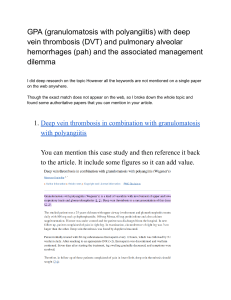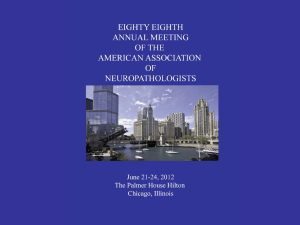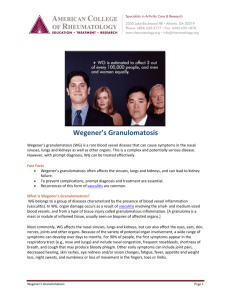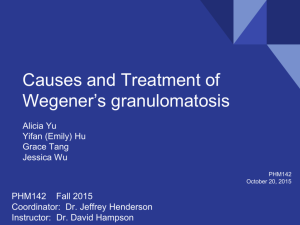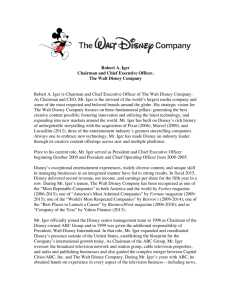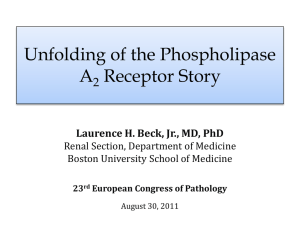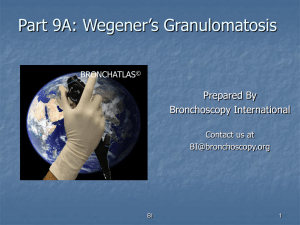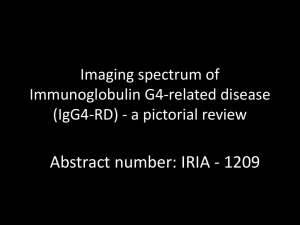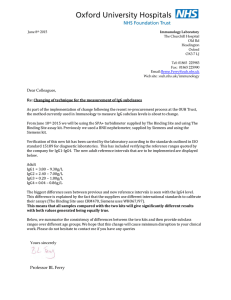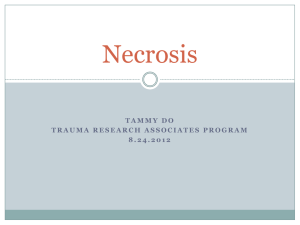Moss: Golden Grapes
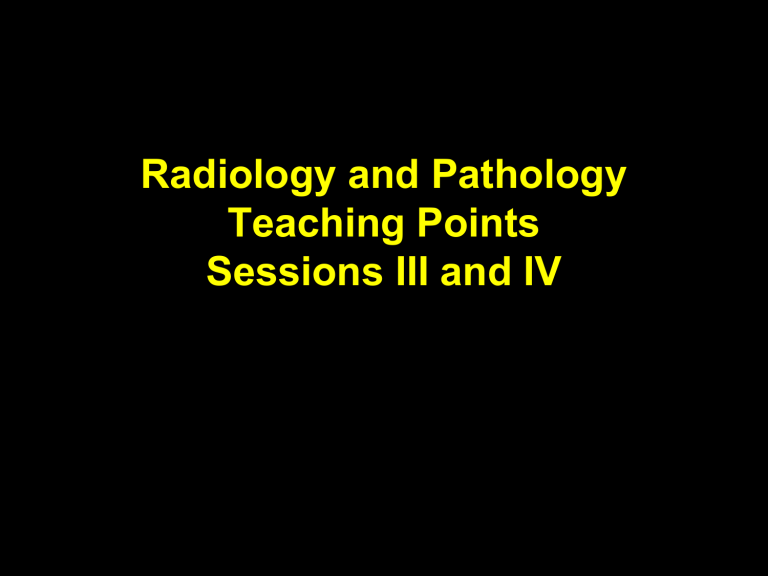
Radiology and Pathology
Teaching Points
Sessions III and IV
Pat Hudgins and Dan Brat
III.1: Sacramentum Gladiatorium
III – Case 1
Processes in sphenoid sinus can affect the orbit/visual pathways
III – Case 1
Meningeal enhancement around inflammatory processes is common
Mucocele with superimposed bacterial infection
Always send cultures if disease could be infectious. Stains would not have revealed the type of organism or therapeutic resistance.
III.2: Diabetes Does Not Explain it All
III – Case 2
Volume loss is hard to quantify
• Corpus callosal thinning
• Vermian atrophy
• Medullary atrophy
III – Case 2
WM changes in unusual places
• Temporal horns and sweeps
III – Case 2
WM changes symmetric
• Int/ext capsule, both frontal and occipital
Polyglucosan bodies accumulate in the central and peripheral nervous systems and are often associated with glycogen branching enzyme (GBE) deficiency
A. Teased-fiber from sural nerve with axonal enlargements due to polyglucosan bodies.
B. Semithin section shows axonal accumulations of glycogen deposits.
(PAS)-positive polyglycosan bodies within the neuropil of the basal pontine gray matter (arrow).
III.3: Double Vision? … Give Your Head a Shake
III – Case 3
Initial MRI
• Volume loss is common, hard to quantify
III – Case 3
Initial MRI 7 months later
Testicular germ cell tumors occasionally regress spontaneously (estimated at 4%) and may manifest later by autoimmune or metastatic disease.
Anti-CRMP5 paraneoplastic disease more often includes cerebellar ataxia, chorea, and ocular manifestations
Pathology of active paraneoplastic cerebellar encephalitis consists of a T-cell infiltrate, generally directed at
Purkinje cells.
III.4: Clues Hidden in the Skin
III – Case 4
Infinite gray scale options mean images can be displayed in weird ways
Chediak-Higashi syndrome is caused by mutations in the LYST gene.
Enlarged, dysfunctional lysosomes in neutrophils prevent appropriate immune responses
Amyloid deposits (SAA type) reflect widespread acute inflammation
III.5: Spots, spots everywhere, and not a spot to see
III – Case 5
FLAIR T2 FFE
III – Case 5
FLAIR Sag
III – Case 5
Volumetric images
Obtained in one plane, others are reformats
RMSF is caused by Rickettsia rickettsii , a species of bacterium that is spread to humans by Dermacentor ticks
Serology for IgG is most common laboratory test;
Immunohistochemistry and PCR are also possible.
Session III: What have we learned?
• Put sphenoid sinus/central skull base on your checklist
• Volume loss is like pornography: you know it when you see it, but no good definition
• A good Radiology Dept standardizes gray scale display
Session III: What have we learned?
• Paraneoplastic disease can be the first manifestation of neoplastic disease and is due to antibody-mediated immune response to neuronal antigens.
• Genetic diagnosis of rare diseases (polyglucosan body disease; Chediak-Higashi) is becoming more frequent; the pathology remains important to understand.
• Serology for IgG is most common laboratory test for
RMSF
IV.1: Raise Your Grade Point Average
IV – Case 1
T1 is so good, why put on fat sat?
Granulomatosis with Polyangiitis (GPA) (Wegener ’ s granulomatosis) is a NECROTIZING ANGIITIS with……
……Granulomatous Inflammation (to distinguish from
Microscopic polyangiitis)
The active vasculitic disease can be difficult to find, but the necrosis and granulomatous inflammation are abundant.
IV – Case 2
Microadenoma is usually focal and discrete
IV – Case 2
More than an adenoma can occur in the pituitary gland
Pathologist ’ s favorite saying: “ when there is an issue, get some tissue!!
”
Tissue-based diagnosis in this case would not have been definitive, most likely….
….but it would have ruled out adenoma before radiation.
Not all sellar lesions associated with increased prolactin levels are adenomas.
Adenoma Wegener ’ s Granulomatosis
IV.3: Admissions Ad Nauseum:
A Cryptic Case of Chiasmopathy
IV – Case 3
Whenever there are multiple opinions re:
Hydrocephalus or
Leptomeningeal enhancement:
The next steps should be…
1)Lumbar puncture
2)Ophthalmoscopic exam
Cryptococcal organisms (budding ovoid yeast forms) have a thick mucoid capsule that can be seen with mucicarmine. Also seen on silver stains.
The degree of inflammation may be low in immunocompromised patients.
Immune reconstitution (IRIS) associated with cryptococcus in AIDS patients can lead to abrupt and severe symptoms.
IV.4: A case of Mistaken Identity
IV – Case 4
Yes, it had long T1 and T2, but…
IV – Case 4
there were some hints…..
↑ Vascularity Necrosis
High grade gliomas in children are fatal diseases, like adults, but have distinctive sites, molecular profiles and mutations.
The presence of necrosis would qualify this case as a glioblastoma, WHO grade IV.
The most frequent congenital brain tumors are teratomas, astrocytomas, PNETs and choroid plexus papillomas.
IV.5: OMG, I can't C.
IV – Case 5
DDx for dural enhancement is long
1) Normal dura
• Post-op
2) Edematous dura
• Post-LP
3) Invaded dura
• Granulomatous disease
• Infection
• Meningioma
• Hemangiopericytoma
• Mets
Mass-forming lesions due to lymphoplasmacytic infiltrates and sclerosis, a raised serum IgG4 level and increased IgG4+ plasma cells in the involved tissues.
The understanding of IgG4-Related Sclerosing
Disease is still evolving.
Would have been called “ inflammatory pseudotumor ”
“ hypertrophic pachymeningitis ” prior to IgG4-RD
IgG IgG4
Session IV: What have we learned?
• Don’t put fat sat on T1, you lose the advantages
• More than adenomas happen in the pituitary
• If you’re going to call a JPA, it shouldn’t be a vascular or necrotic mass
• Especially if a child is not NF-1, be very careful about calling a hypothalamic JPA
• Diff Dx for sick dura is really long
Session IV: What have we learned?
• Granulomatosis with Polyangiitis (Wegener’s granulomatosis) is an aggressive necrotizing angiitis; difficult to diagnose based strictly on histologic findings.
• “When in doubt, dig it out”
• IgG4-Related Sclerosing Disease is a newly described form of inflammatory pseudotumor with elevated serum IgG4 level and IgG4+ plasma cells in tissues….still evolving
• Midline enhancing masses in childhood can be due to low or high grade astrocytomas; the presence of necrosis suggests a glioblastoma, WHO grade IV
